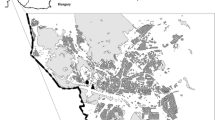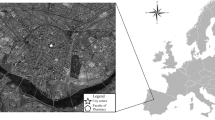Abstract
Since the end of the 1990s, the aerobiological network managed by the Regional Environmental Agency in Emilia-Romagna, Italy, started a systematic monitoring of different types of fungal spores, in particular Alternaria. This activity is of outstanding interest due to the various detrimental effects on human beings and on vegetation associated with Alternaria spores presence in the atmosphere. Daily concentration values of Alternaria spores are available from the Emilia-Romagna network in 10 stations. The availability of these data allows to set up a detailed analysis of the presence of Alternaria spores in different climatic and environmental settlements. The 19-year database of daily spore concentrations in most of the stations (1999–2017) can also support a preliminary analysis of climatic trends. A synthetic characterization of the main features associated with the presence and amount of Alternaria spores will be presented in this work. The period with the highest values of concentration in most of the measuring stations covers the warm season, with two main peaks of spore production in early and late summer. The most relevant trends for Alternaria season are mainly associated with an increase in the length of the period when spores are present. As for the amount of spores, signals are generally less evident, indicating a predominant decrease in the spore amount.

Similar content being viewed by others
References
Corden, J. M., Millington, W. M., & Mullins, J. (2003). Long-term trends and regional variation in the aeroallergen Alternaria in Cardiff and Derby UK—Are differences in climate and cereal production having an effect? Aerobiologia,19, 191–199.
D’Amato, G., Chatzigeorgiou, G., Corsico, R., Gioulekas, D., Jäger, L., Jäger, S., et al. (1997). Evaluation of the prevalence of skin prick test positivity to Alternaria and Cladosporium in patients with suspected respiratory allergy. A European multicenter study promoted by the subcommittee on aerobiology and environmental aspects of inhalant allergens of the european academy of allergology and clinical immunology. Allergy,52, 711–716.
Damialis, A., Vokou, D., Gioulekas, D., & Halley, J. M. (2015). Long-term trends in airborne fungal-spore concentrations: A comparison with pollen. Fungal Ecology,13, 150–156.
Escuredo, O., Seijo, M. C., Fernandez-Gonzalez, M., & Iglesias, I. (2011). Effects of meteorological factors on the levels of Alternaria spores on a potato crop. International Journal of Biometeorology,55, 243–252.
Gioulekas, D., Damialis, A., Papakosta, D., Spieksma, F. T. M., Giouleka, P., & Patakas, D. (2004). Allergenic fungi spore records (15 years) and sensitization in patients with respiratory allergy in Thessaloniki-Greece. Journal of Investigational Allergology and Clinical Immunology,14, 225–231.
Grinn-Gofron, A., Strzelczak, A., Stepalska, D., & Myszkowska, D. (2016). A 10-year study of Alternaria and Cladosporium in two Polish cities (Szczecin and Cracow) and relationship with the meteorological parameters. Aerobiologia,32, 83–94.
Gur, L., Reuveni, M., & Cohen, Y. (2017). Occurrence and etiology of Alternaria leaf blotch and fruit spot of apple caused by Alternaria alternate f. sp. mali on cv. pink lady in Israel. European Journal of Plant Pathology,147, 695–708.
Harteveld, D. O. C., Akinsanmi, O. A., Chandra, K., & Drenth, A. (2014). Timing of infection and development of Alternaria diseases in the canopy of apple trees. Plant Disease,98, 401–408.
Jambhulkar, P. P., Jambhulkar, N., Meghwal, M., & Ameta, G. S. (2016). Altering conidial dispersal of Alternaria solani by modifying microclimate in tomato crop canopy. The Plant Pathology Journal,32(6), 508–518.
Kendall, M. G. (1976). Rank correlation methods (4th ed.). London: Charles Griffin.
Mann, H. B., & Whitney, D. R. (1947). On a test of whether one of two random variables is stochastically larger than the other. Annals of Mathematical Statistics,18(1), 50–60.
Moran, P. A. P. (1950). Notes on continuous stochastic phenomena. Biometrika,37(1), 17–23.
R Core Team. (2018). R: A language and environment for statistical computing. R Foundation for Statistical Computing, Vienna, Austria. https://www.R-project.org/.
Sen, P. K. (1968). Estimates of the regression coefficient based on Kendall’s tau. Journal of the American Statistical Association,63, 1379–1389.
Theil, H. (1950). A rank-invariant method of linear and polynomial regression analysis, I-II-III. In Proceedings of the Koninklijke Nederlandse Akademie van Wetenschappen Series A (Vol. 53, pp. 386–392, 521–525, 1397–1412).
Author information
Authors and Affiliations
Corresponding author
Rights and permissions
About this article
Cite this article
Marchesi, S. Alternaria spores in Emilia-Romagna, Northern Italy: current diffusion and trends. Aerobiologia 36, 31–36 (2020). https://doi.org/10.1007/s10453-019-09621-y
Received:
Accepted:
Published:
Issue Date:
DOI: https://doi.org/10.1007/s10453-019-09621-y




